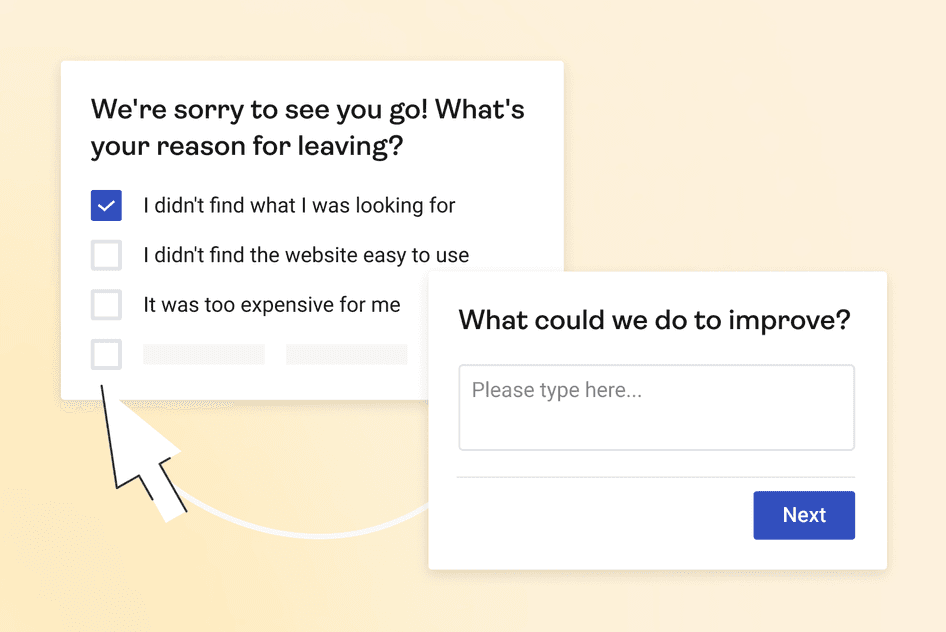Every time someone finishes visiting a store online, we can either learn something new or make a sale. An exit intent survey, also known as an ecommerce churn survey or just an exit survey, is like a quick questionnaire that asks why someone is leaving your website.
When we understand why people leave, we can make changes to stop it from happening so much, like making sure they find what they need before they go. For instance, if someone says they’re leaving because they couldn’t find enough information, we could make sure to put more details where they can easily see them on the page.
What are the benefits of using a website exit survey?
Asking visitors why they leave a page can:
- Make the site better: Find out if there are things stopping visitors from using the site as you want. They might even give ideas on how to make it easier to use.
- Get more people to buy things: Knowing why people leave helps understand how to stop them from leaving. Find out what’s stopping them from buying and fix it.
- Keep people interested in your brand: Sometimes, visitors don’t buy the first time they come. Use a survey to ask for their contact info so you can keep in touch. Give them something useful in return, like a webinar invite or a checklist.
What times its appropriate to utilise an exit intent survey?
To make your website and online store better, it’s important to learn from real customers. When you know why someone wants to leave your page, you can:
- Decrease the number of people who leave quickly by finding and fixing issues.
- Highlight what customers like so they see it first.
- Figure out how you stack up against other businesses in the eyes of potential customers.
What are the best locations to position an exit survey on your website?
Depending on what part of the sales or marketing process you want to make better & what kind of business you have, you can put an exit survey on different pages of your website:
- Checkout page: If you run an online store, you can learn a lot by asking why people leave without buying anything. Maybe your payment options don’t work for everyone, or customers are worried about extra costs.
- Product page: If certain products aren’t selling well, you can ask why. Maybe the product descriptions aren’t clear, or there aren’t enough pictures or reviews.
- Pricing page: Especially for online software businesses, the pricing page is super important. If people leave without signing up, you can find out if your prices are confusing or if there are ways to make your packages better.
- Landing pages: If you’re spending money on ads, you want people to actually do something after they click. If they’re leaving without signing up or buying, you can ask why. Maybe you need to add more proof that your product is good, like customer reviews.
- Homepage: Lots of people see your homepage, especially if they’re new to your site. Even if they don’t buy anything right away, you can ask if they want to stay in touch by joining your email list or hearing about events you’re hosting.
What elements are included in exit intent survey template?
Exit intent survey templates offer people a list of reasons why they left a page, along with a chance to explain more if they want to.
How can you apply insights gained from an exit intent survey?
After gathering exit intent data, here’s how to use it effectively:
Focus on fixing issues causing people to leave:
If you’re deciding what to work on next for your website, knowing why people leave can guide you. Start with the things that make visitors leave and prioritise them to turn more visitors into customers.
Understand what different groups of people like:
Look at why people leave across different groups of customers. This helps you customise your website for each group. Test different designs based on what people say and make the website better for everyone.
Solve problems on pages before they become big:
When lots of people leave a page, it’s a sign there’s a problem. But sometimes, you need more information to fix it. Watching recordings of how people use your website can help you figure out what’s wrong and stop it from happening again.







